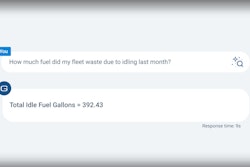
Drivers who choose not to wear their seatbelts are more likely to get into an accident.
According to May 2023 research by the data science team at Verizon Connect in an investigation of more than 7 million videos from Verizon Connect dashcam footage, commercial drivers operate vehicles without a seat belt fastened in one out of every 10 instances. The study also revealed that 40% of all videos showed a vehicle exceeding the posted speed limit. For more than two decades, speeding has contributed to approximately one-third of all motor vehicle fatalities, and 64% of truck drivers killed in automobile accidents were not wearing seatbelts.

How are fleets and owner-operators using telematics? Find out with this comprehensive research from the editors at CCJ.
Download to access insights on what telematics solutions fleets/owner-operators are using, how telematics influences business decisions and more.
“Generally, the driver’s actions that are captured most often are common occurrences like following the vehicle in front of you too closely and speeding. Drivers being unbelted is another action that we see quite often, especially as the detection systems surrounding unbelted drivers get more and more sophisticated,” said Kyle Warlick, a senior analyst in client intelligence at Lytx, a video telematics and fleet management solutions provider. “While driving unbelted has less of a direct relationship to collisions, as opposed to speeding and following too closely, we have seen that people who get into collisions often have been driving unbelted in the past. This is likely because drivers who are not engaging in safe driving by putting on their seatbelts are more likely to ignore other safety regulations.”
[RELATED: AI-enabled dashcams can help fleets reduce insurance costs]
Because of that correlation, Verizon Connect has rolled out some enhancements to its AI dashcam, including new AI tags for speeding and unfastened seat belt detection, to provide additional context in each video so fleet managers can more efficiently analyze, classify and prioritize harsh driving events. Verizon Connect’s Cloud AI video analytics engine provides additional context to each video so fleet managers can cut down the time needed to understand what needs their immediate attention. With Cloud AI analysis, fleet managers can view each video with severity labeled alongside additional tags including tailgating, rolling stop and phone distraction. By enhancing its Cloud AI to identify and tag speeding and unfastened seat belt events, Verizon Connect enables fleet managers to zero in on the opportunities to coach for better driving behaviors.
Using telematics to combat risky driver behavior
Gary Johnson, head of safety and compliance strategy at fleet management company Motive, said it is important for telematics providers to consistently update and innovate with their systems to track these events and alert drivers and operators to unsafe commercial driving behaviors (phone calls, texting, rolling stops, not using seat belts, close following) that lead to accidents and fatalities.
The Virginia Tech Transportation Institute recently performed a study highlighting that Motive’s AI dashcam outperformed the models of two AI dashcams deployed by other providers in the market, showing that AI accuracy, which can depend on camera placement and time of day as light conditions change, varies among providers.
“Accurate AI is crucial. Preventing the behaviors observed in the study is key to decreasing distracted driving accidents, which last year saw more U.S. pedestrians killed than at any other time in the last 40 years,” Johnson said. “… Accident prevention is made possible through risk detection that is both instant and precise. This can be the difference between preventing an accident and picking up the pieces after it happens. So things that drive these risk-detection behaviors and awareness are going to be key considerations.”
[RELATED: AI accuracy is critical in avoiding false alerts and alert fatigue]
In Idelic’s book, a seatbelt – or lack thereof – isn’t at the top of the list of considerations. Brian Filip, chief technology officer at Idelic, said lack of a seatbelt is a common behavior driver-facing cameras capture, but Idelic doesn’t weight seatbelt usage heavily in its scoring system as an indicator that a driver is more likely to get into an accident. The more common indicators of accident risk are drowsiness and phone usage, he said.
“I think from an overall risk mitigation perspective, I can't think of any reason why a fleet carrier shouldn't be very actively enforcing their seatbelt policy,” he said. “When I say that we don't weight this heavily. We don't weight it as heavily in terms of the likelihood that they will get into an accident. If you get into an accident, obviously having the seatbelt on is critical, but it doesn't necessarily indicate that you're more likely to get into an accident.”
Idelic aggregates all the data coming from a telematics provider’s sensors and cameras and combines it with FMCSA, training and accident data before analyzing it using machine learning models to help fleets understand which drivers present the greatest risk of getting into an accident in the next 90 days. The company also provides coaching tools to help fleets mitigate risks.
Filip said telematics providers are working to improve their AI and machine learning to have more impactful interventions when drivers record unsafe behavior, but there are some gaps: one, visibility into data because they lack context from other sources like FMCSA and accident data; and two, a greater focus on training versus coaching and trying to automate that process through things like video to make it a more hands-off approach to alleviate back-office staff.
When it comes to driver intervention, he said less automation and more human interaction is more effective. That’s why Idelic likes to differentiate between training and coaching, he said.
“Training, we usually see that as more of a broad approach to serve all drivers with a baseline of knowledge. We see the training is often being used if there is a serious event being detected by the telematics provider … We always recommend to our customers that they should still be monitoring their telematics alerts dashboard every day for the serious events and that they should be immediately having conversations with the drivers about that specific event,” Filip said. “Where Idelic really helps is seeing the trends that aren't as obvious from a single event and letting them know where the risk is associated with that. In those situations, we push more for coaching. Training is the giving of information in a manner that instructs a group or an individual. Coaching is a developmental approach to working with and interacting with those people. So training tends to be more of a one-way conversation: watch the video, read the PowerPoint, listen to the lecture. Whereas coaching is more of a two-way conversation. 'Tell me what you're doing in the cab. Why are you doing that? Do you understand this alternative? Have you tried this?' It's really interacting with the driver to try to have a greater impact.”
Warlick said Lytx finds that training and coaching generally work best when combined for an effective driver safety program. But the real gap, he said, is not having a dashcam or telematics at all.












